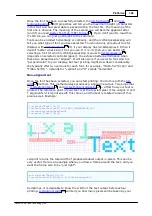
384
Platforms
©2000-2008 Tibbo Technology Inc.
Pat Object
The pat object allows you to "play" signal patters on up to five LED pairs, each pair
consisting of a green and red LED.
The channel to work with is selected through the
property. The first
channel (channel 0) is the primary channel of your system. It utilizes green and
red status LEDs that are present on all external devices, boards, and some
modules offered by Tibbo. All modules have SG and SR I/O lines that are meant for
controlling external status LEDs. Note that when the Tibbo BASIC application is not
running, green and red status LEDs are used to display various
.
The remaining four channels (channel 1-4) are identical in function, but use
regular I/O lines of Tibbo devices. Moreover,
and
properties allow you to flexibly map the green and red LED control lines of each
channel to any I/O lines of the device.
The pattern you play can be up to 16 steps long. Each "step" can be either
"-" (both LEDs off), "R" (red LED on), "G" (green LED on), or "B" (both LEDs on).
You can also define whether the pattern will only execute once or loop and play
indefinitely. Additionally, you can make the pattern play at a normal, double, or
quadruple speed.
You load the new pattern to play with the
method. If the pattern is
looped it will continue playing until you change it. If the pattern is not looped it will
play once and then the
event will be generated. When the event handler
is entered, the pat.channel property will be automatically set to the channel
number for which the event was generated.
LED patterns offer a convenient way to tell the user what your system is doing.
You can devise different patterns for different states of your device.
Here is a simple example in which we keep the green LED on at all times, except
when the button is pressed, after which the green LED is turned off and the red
LED blinks three times fast. Additionally, both green and red LEDs blink 4 times on
startup. In this example we work on channel 0:
Sub
On
_sys_init
pat.channel=0
'not really necessary since 0 is the default value for
this property
pat.play("B-B-B-B-",PL_PAT_CANINT)
End
Sub
Sub
On
_button_pressed
pat.play("*R-R-R-",PL_PAT_CANINT)
End
Sub
Sub
On
_pat
If
pat.channel=0
Then
'not really necessary since we are not using
any other channels
pat.play("~G",PL_PAT_CANINT)
End
If
End
Sub
In the above example, the power-up pattern is loaded inside the
event handler. This is not a looped pattern, so once it finishes playing the
event is generated and the "permanent" pattern "green LED on" is loaded
inside this event's handler. This new pattern is looped (notice "~"). When the
button is pressed, a fast pattern (notice "*") is loaded. This one makes the red LED
385
184
385
387
386
386
220
386
















































